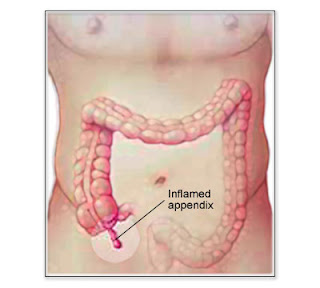 Acute appendicitis is defined as the acute inflammation of the appendix. It is considered to be the most common cause of abdominal pain and distress in children and teenagers worldwide (ages 4-15). The appendix is a channel in its interior that communicates with the large intestine where feces semifluidas.
Acute appendicitis is defined as the acute inflammation of the appendix. It is considered to be the most common cause of abdominal pain and distress in children and teenagers worldwide (ages 4-15). The appendix is a channel in its interior that communicates with the large intestine where feces semifluidas.
The appendix is a small pouch attached to your large intestine. It is thought that appendicitis begins when the opening from the appendix into the cecum becomes blocked. The blockage may be due to a build-up of thick mucus within the appendix or to stool that enters the appendix from the cecum. When the appendix is blocked by calculus and feces or it is squeezed by the lymph nodes (due to bacterial infection, the lymph nodes usually become swollen and press against the appendix), it swells and usually doesn't receive enough blood. Bacteria grow inside the appendix, eventually causing its death. In acute appendicitis, the inflammation of the appendix is serious and can lead to complications (perforation, gangrene, sepsis).
Acute appendicitis is caused in most cases, usually by a fossilized feces (fecalito) that obstructs the appendiceal channel. Acute appendicitis is the most common cause of acute abdominal pain and its treatment is surgical and emergency.
The most common symptoms of acute appendicitis are intense, continuous abdominal pain (at first it occurs in the umbilical region and later locates in the right lower region of the abdomen) that usually amplifies during movement, poor appetite, nausea, vomiting, constipation or diarrhea and fever. Vomiting and anorexia can occur after the feeling of pain. Besides, an elevated body temperature is a sign of an ongoing inflammation in the body. In atypical forms of acute appendicitis, the patients may have only one symptom or they may not have any symptoms at all! This complicates the process of correctly diagnosing acute appendicitis and the only effective means of discovering the illness are abdominal computerized tomography, blood analysis and detailed physical examination.
The most frequent complication is that the wall of the appendix is necrosa (gangrenous appendicitis), causing a perforation, with consequent generalized peritonitis, or in some cases the adjacent bowel loops are affected in such a way that causes perforation of the small intestine.
Another complication is the possibility that the omentum can join restricting peritonitis in the right iliac fossa. Fibrosis and inflammation produce a persistent right iliac fossa mass (mass apendicial). This can be solved through healing by formation of an abscess to drain to the surface or by drilling with generalized peritonitis.
The surgical intervention performed in acute appendicitis is called appendectomy. If acute appendicitis is treated in time, the patients recover quickly and effortless. Most patients are fully recovered within 4 weeks from surgery. However, in the case of complicated acute appendicitis, the patients require special monitoring before and long after the surgical treatment. Complicated acute appendicitis is life-threatening and the rate of mortality in patients with this form of illness is considerably high. Acute appendicitis requires immediate treatment.
Diagnosis of Acute Appendicitis
This disorder is mainly based on clinical diagnosis, the doctor makes the patient's physical examination (signs of Mc Burney Blumberg or positive), other relevant data that help us to diagnose the taking of a blood Biometría showing (leukocytosis of 10,000 to 15,000 leuc/mm3 and normal urinary tract examination (to rule out a possible infection and the differential diagnosis).
Prevention and Treatment of Acute Appendicitis
1. Antibiotics almost always useful in Appendicitis.
2. Appendectomy surgery removal of the appendix.
3. Intravenous (IV) fluids decrease the risk for wound infections after surgery.
4. Appendicitis is less common in people who eat foods high in fiber so eat very low.
Healing Pain in Acute Appendicitis
1. Assess the level of pain, location and characteristics of pain.
Rationale: To determine the extent of pain and is an indicator of early to be able to give further action.
2. Encourage deep breathing.
Rationale: deep breathing, can breathe oxygen adequately, so that the muscles into relaxation so as to reduce pain.
3. Perform gate control.
Rationale: The gate control large diameter nerve stimulating small-diameter nerve so that pain stimuli are not forwarded to the hypothalamus.
4. Give analgesics.
Rationale: As a prophylactic in order to relieve pain (if already know the symptoms for sure).
Search This Blog
Healing Pain in Acute Appendicitis
Subscribe to:
Post Comments (Atom)
Labels
- Acute Appendicitis (1)
- Bananas (1)
- Benefits of Fruits (3)
- Cataract (1)
- Dengue Fever (2)
- Fluid Volume Deficit (1)
- Health Articles (2)
- Hyperthermia (1)
- Mangoes (1)
- Nasal Polyps (1)
- Natural Treatment (2)
- Nursing Care Plan (2)
- Nursing Diagnosis and Interventions (3)
- Rabies (1)
Labels
- Hyperthermia (1)
About Me
Powered by Blogger.
Popular Posts
-
Every normal human being has a sensory organ, the organ of smell, hearing, taste, and sight. These organs are not uncommon or even very pro...
-
Definition Cataract is a condition in which the normally clear lens of the eye becomes cloudy and clear change. Cataract is the opacit...
-
Rabies is a zoonotic disease (a disease that is transmitted from animals to humans) that is caused by a virus. It is known to be present ...
-
Fluid Volume Deficit Decreased intravascular, interstitial, and/or intracellular fluid (refers to dehydration, water loss alone without ...
-
Hyperthermia is defined as a temperature greater than 37.5–38.3 °C (100–101 °F), depending on the reference used, that occurs without a ch...






0 komentar:
Post a Comment